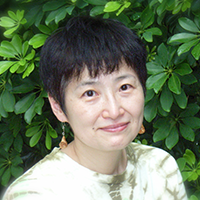Set of kanshitsu vessels in shape of seashell with stencil design.
- Lacquerware
- Presented in 2013
- H 3.5 x W 17.0 x D 12.5 cm
- Contact for Price
| Category | Lacquerware |
|---|---|
| Year Presented | 2013 |
| Dimensions | H 3.5 x W 17.0 x D 12.5 cm |
| Exhibition | The 60th Japan Traditional Kōgei Exhibition |
-
Dry lacquer
For works of dry lacquer (kanshitsu), first a clay form is created and plaster is used to take a mold of the form. Next, repeated layers of hemp cloth and lacquer are applied to the mold until they are built up to the desired thickness. Finally, the mold is removed and additional coats of lacquer are applied to finish the piece. The hemp fibers are strengthened when the lacquer bonds with them, making dry lacquer an excellent technique for creating sturdy forms with a significant degree of freedom.
Kiyomi Okukubo

Lacquer sap is collected by making many deep cuts into lacquer tree trunks and precisely for that reason, I wish to show my respect and appreciation for this gift of nature by making the maximum use of the characteristics of lacquer, such as its strength after hardening or its deep luster. I make plain bases by pasting layers of hemp cloth onto a fine detailed plaster mold; I also make dynamic forms by the hand-twisting of ropes and non-woven fabric into which lacquer first infiltrates, and then I leave the natural hardening property of lacquer to give further free shape to my workpieces. When applying decoration, guided by the red square boxes made for the household effects of feudal lords, I repeatedly explore ways to ensure that the red texture appears as a pattern similar to maki-e (sprinkled picture decoration) or raden (mother-of-pearl inlay).

